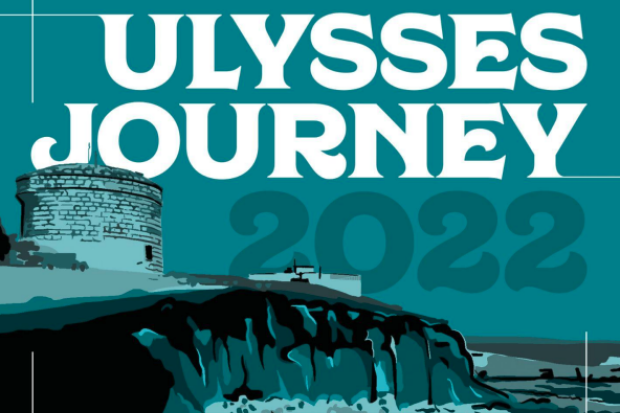
Double bassist Malachy Robinson with his grandfather, the composer Joseph Groocock. (Photo courtesy of Malachy Robinson)
Against Typecasting
When I was in college, I knew a guy who played the double bass. He kept it in a hard case, with shoulder straps so he could wear it like a backpack. He had a small frame, but, in crowds, he was always visible as the neck of his instrument jutted up, swaying metronome-like as he walked. It makes a fitting analogy for the instrument: eccentric in personality, a little unwieldy, unmissable but rarely in the spotlight.
An album for such an instrument is by its nature at least a little polemical, making the case for it as a solo instrument by spotlighting its strengths and challenging its perceived weaknesses. Such an album also tends towards the highly personal. In an article about The Irish Double Bass for The Strad, Malachy Robinson wrote about his grandfather Joseph Groocock, whose cello sonata served as an impetus for this album. Robinson adapted the sonata for double bass, then built an album around it from works he had premièred through his career, ending with the performer singing the Irish air ‘My Lagan Love’ to his own accompaniment.
Lyricism and power
The first few tracks on the album push strongly against typecasting the instrument. Eoghan Desmond’s ‘Variations for solo double bass’ place a strong emphasis on lyricism and agility while also embracing the low register and power it’s capable of. The fifth variation sees the music rise from swampy verdancy, making for an ending of dusky pizzicati.
Robinson’s arrangement of Groocock’s cello sonata, performed with Gary Beecher playing the piano part, explores the greater range of the double bass while maintaining the warm sound of the higher passages. As the composer’s grandson, Robinson’s affinity with this work felt particularly close, and there’s an extent to which it fulfils the role of the album’s centrepiece. It would come as no surprise to a first-time listener that Groocock was highly regarded as a teacher of counterpoint in his lifetime. His music is the most conservative here – Brahms-inflected part-writing with a three-movement, fast–slow–fast structure – but nonetheless skilful and technically deft.
John Kinsella’s ‘Una Giga Para Carlos’ is the greatest show of acrobatics on the album, swinging from register to register while maintaining a constant momentum. Kevin O’Connell’s ‘Slattar’ draws on Norwegian folk fiddling, bounding through the low register and introducing, then immediately subverting, rhythmic ideas. And in ‘Bodhran’, Ryan Molloy evokes that instrument with low microtonal fluctuations and glissandi, the sheer weight of which feel like shifting gravity on another world.
An answer that never comes
If the first works on the album challenged the limitations of the double bass, these latter works are more in line with what might be expected from it, emphasising the low register and rich resonance. The end of the Kinsella, for instance, slides up and off the bass, leaving a chord ringing like a plucked harp. That resonance becomes a core component of Ian Wilson’s ‘Pianura’, which opens with the instrument asking a question, then waiting for an answer that never comes. The spaces between are not-quite-silences, before the piece descends into rumbling, pulsing growls. Wilson’s ear for timbre shows in the harmonics, which evoke brass instruments.
In ‘Maps of Awakening’, Deirdre Gribbin shows an equally good ear for timbre, creating tension in an instant, and using a pair of spoons to play the bass. From here, she builds harmony – a surprise major chord! – and melody, before reaching an end that drifts and scatters.
Judith Ring’s ‘Twilight’ provides a sense of emotional closure. (After this, the final track, ‘My Lagan Love’ has very much the feeling of an encore.) Her work begins with a plaintive, questioning pair of notes, which, when answered, become a slowly flowing, melting passage. Ring has an excellent instinct for the right moment to deploy an open bass string, introducing a melody that pulls like a heavy chain around your neck before climbing, glowing and eventually dwindling and diminishing in harmonic glissandi at the end.
While there’s not much to connect the works on this album to one another, Robinson’s connection to all of them is clear. He plays with a commanding and secure agility, but his ear and mind are sensitive enough to allow the music to breathe in quieter moments. The double bass has, over the twentieth and twenty-first centuries, moved beyond its role as an instrument that only plays a supporting position, with any number of works written to explore its unique character and qualities. But The Irish Double Bass states the case plainly, inviting examination of the instrument’s lyricism, its resonance, its agility, and its range.
The Irish Double Bass is available to purchase on Bandcamp. Visit https://malachyrobinson.bandcamp.com/album/the-irish-double-bass. Click on the image below to listen.
Published on 24 February 2022
Brendan Finan is a teacher and writer. Visit www.brendanfinan.net.

















